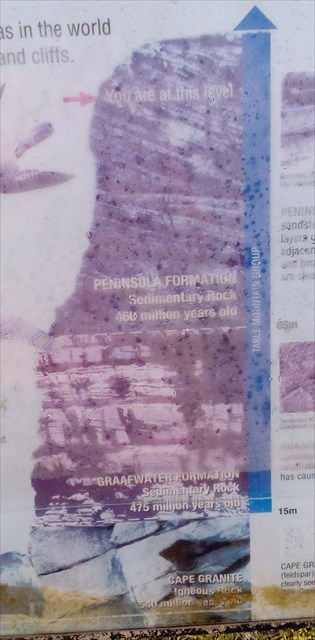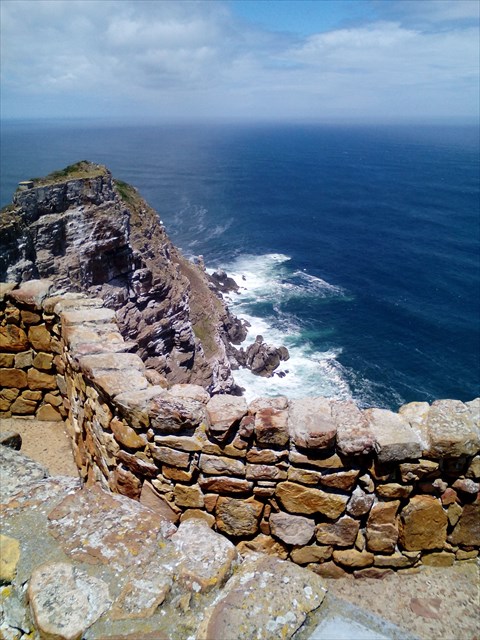We have wanted to do an earthcache for some time now, but as we are absolute “geological” amateurs we wanted something that would be easy and would appeal to other amateurs like ourselves and maybe to first time earthcachers.
Please be mindful of any signs prohibiting access along the pathway as there are spots where re-vegetating is being encouraged.
When we visited the Cape Point nature reserve and took the long walk along the Light House Keepers Trail, to go to the traditional cache there, (vespax’s Sailors’ Star GCVDHN), we thought that it would be very nice if one could bag two caches here on the tip of Cape Point, one of the most beautiful places on earth.
Just to the right of the path there is an information board, slightly worse for wear, with illustration of the rock formations at Cape Point.
Edit: Apparently the notice board has been removed. It is possible to do the cache without the board.

The Cape Peninsula is composed of three main rock formations of varying ages.
- The Malmesbury Group, around 540 million years old, consists of dark grey mudstones and lighter coloured sandstones. Examples of this formation can be seen on Signal Hill and the lower slopes of Devil’s Peak
- Cape Granite, around 540 million years old, is much harder and coarse-grained characterised by large white feldspar crystals, shimmering flakes of black mica and grey glassy quartz. This formation is the foundation for most of the Table Mountain Chain and good examples of granite outcrops can be seen at Boulders, Chapman’s Peak and Lion’s Head.
- Table Mountain Group, only 520 million years old, comprised of a further three formations:
- The Graafwater formation: This layer is around 25m-65m thick and consists of sandstone and mudstone in red and purple hues.
- The Peninsula Formation comprised of light grey, pebbly sandstones, forms the bulk of Table Mountain and is around 700m thick.
- The Pakhuis Formation found on the top of Table Mountain and identifiable by glacially deposited pebbles of sandstone.
Refer University of Cape Town, Department of Geosciences
According to Wikipedia –
Table Mountain Sandstone (Geological Formation)
The Table Mountain Sandstone (TMS) is a group of rock formations within the Cape Supergroup sequence of rocks. Although still widely used in common parlance, the term TMS is no longer formally recognized; the correct name is the "Table Mountain Group" (TMG). The sequence is dominated by quartzites of very low metamorphic grade and Ordovician age.
The Ordovician Period lasted almost 45 million years, beginning 488.3 million years ago and ending 443.7 million years ago. During this period, the area north of the tropics was almost entirely ocean, and most of the world's land was collected into the southern supercontinent Gondwana. www.ucmp.berkeley.edu/ordovician/ordovician.php
(For the logging purposes of this cache there is no reason to know about the Ordovician Period. We just found it to be very interesting!)
The formation accumulated in a marine delta environment exposed to wave action on the margins of pre-Pangaean South Africa. The massive beds of sand have hardened to become an extremely weather-resistant sedimentary rock that is some two thousand metres thick in places. The rock forms tall crags.
(200 million years, or thereabouts, ago, all the present day continents were conbined to form a super continent called Pangea.)
The Cape Supergroup lies above an unconformity that separates it from the shales and hornfelses of the Malmesbury Formation and the intrusive Cape Granite, both of late Precambrian age. Many of the mountain ranges of the Western Cape are composed in the main of sandstones of the TMG. The old name, Table Mountain Sandstone (TMS), is derived from the famous landmark in Cape Town, Table Mountain. Formally named formations within the TMG include the Graafwater Formation (sandstone, siltstone, shale), Peninsula Formation (quartzitic sandstone), Pakhuis Formation (tillite) and Cederberg Formation (sandstone, siltstone).

Looking down towards the “new” lighthouse at Diaz Point, built in 1919, one can observe the beautiful layers of rock visible.

To qualify to log this earthcache, please answer the following questions and email us your answers.
- Looking towards Diaz Point and the newer lighthouse, you will notice a very interesting rock formation standing quite alone. Explain how, in your opinion, this formation originated?
- Standing just to the side of the information board, and looking towards the original lighthouse, how many layers of rock do you see?
- What rock formations would those layers be? (a) Try and determine which layers are from the various groupings? (b) Which layers are unlikely to be the Cape Granite? (c) Where is the Table Mountain sandstone likely to be? (d) Please describe any differences that you might have noticed in colour and formation or shapes?
- Please take a photo of yourself and your GPS with one of the mentioned rock formations in the background. This is optional.
Please add any other interesting photos you may have taken.
Thank you for visiting our first earthcache. We hope you found it to be informative and interesting.
